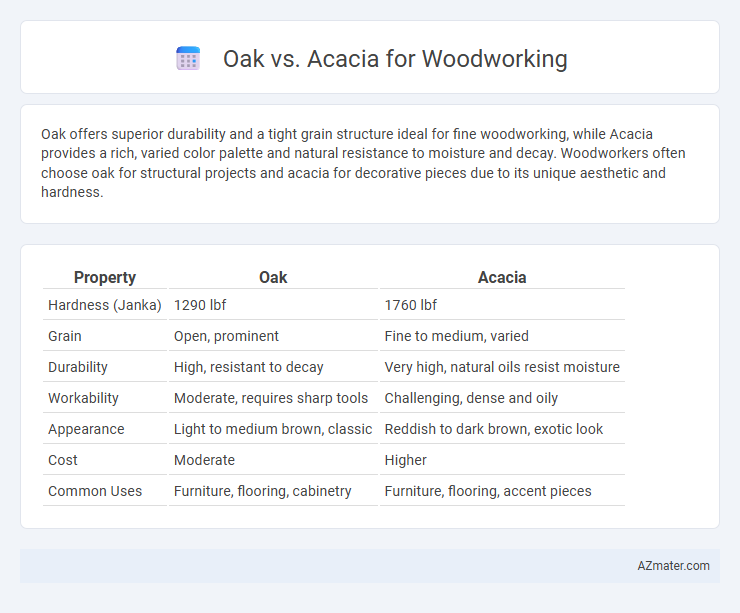Oak offers superior durability and a tight grain structure ideal for fine woodworking, while Acacia provides a rich, varied color palette and natural resistance to moisture and decay. Woodworkers often choose oak for structural projects and acacia for decorative pieces due to its unique aesthetic and hardness.
Table of Comparison
| Property | Oak | Acacia |
|---|---|---|
| Hardness (Janka) | 1290 lbf | 1760 lbf |
| Grain | Open, prominent | Fine to medium, varied |
| Durability | High, resistant to decay | Very high, natural oils resist moisture |
| Workability | Moderate, requires sharp tools | Challenging, dense and oily |
| Appearance | Light to medium brown, classic | Reddish to dark brown, exotic look |
| Cost | Moderate | Higher |
| Common Uses | Furniture, flooring, cabinetry | Furniture, flooring, accent pieces |
Introduction: Oak vs Acacia in Woodworking
Oak and Acacia are prized hardwoods in woodworking, valued for their durability and unique grain patterns. Oak offers exceptional strength and a classic, coarse texture, making it ideal for furniture and flooring that require longevity. Acacia, with its rich color variations and natural resistance to moisture, excels in both indoor and outdoor projects, providing versatility and aesthetic appeal.
Botanical Origins and Growth Patterns
Oak, belonging to the genus Quercus, is a hardwood tree prevalent in the Northern Hemisphere, particularly in North America and Europe, known for its slow growth and dense grain structure. Acacia, primarily from the genus Acacia native to Australia and Africa, grows faster with a more variable grain pattern, often yielding a rich, golden-brown hue. The distinct botanical origins influence their growth rates and cellular structures, making oak more durable and heavy, while acacia offers greater flexibility and a unique aesthetic favored in diverse woodworking applications.
Appearance and Grain Characteristics
Oak features a prominent, open grain with a coarse texture, often displaying distinctive rays and flecks that add character to furniture and flooring. Acacia has a varied grain pattern, ranging from straight to wavy, with a smoother texture and rich, warm tones that deepen over time, making it popular for decorative woodworking. Both woods offer durability, but the visual appeal of oak's pronounced pattern contrasts with acacia's more subtle, intricate grain variations.
Hardness and Durability Comparison
Oak wood, known for its high Janka hardness rating of 1290, offers superior durability and resistance to wear, making it ideal for furniture and flooring projects requiring long-lasting strength. Acacia, with a slightly lower Janka hardness of approximately 1620, is dense and naturally resistant to moisture and decay, providing excellent durability for outdoor and high-use applications. Both woods excel in hardness and durability, but oak's consistent grain and strength suit fine woodworking, while acacia's natural oils enhance its resilience in challenging environments.
Workability: Ease of Cutting and Shaping
Oak offers excellent workability with its coarse grain, making it relatively easy to cut and shape using hand tools and power equipment, although its hardness can require sharp blades and some effort. Acacia also provides good workability but tends to be denser and harder than oak, which might demand more robust tools and create more resistance during cutting and shaping. Both woods respond well to sanding and finishing, but oak's consistent grain structure often results in cleaner, more precise edges and details in woodworking projects.
Common Uses in Furniture and Carpentry
Oak is highly favored in furniture and carpentry for its durability, attractive grain, and resistance to wear, making it ideal for flooring, cabinetry, and heavy-use pieces like dining tables and chairs. Acacia wood, known for its distinctive grain patterns and rich color variations, is commonly used for stylish furniture, decorative veneers, and smaller carpentry projects such as cutting boards and accent pieces. Both woods offer robust structural integrity, but oak is preferred for long-lasting, high-traffic applications while acacia excels in aesthetic-focused woodworking.
Finishing: Staining, Oiling, and Sealing
Oak's open grain structure readily absorbs stains, allowing even and vibrant finishes that highlight its pronounced grain patterns for woodworking projects. Acacia's dense, oily wood naturally resists stains, often requiring sanding or specialized pre-treatments to achieve uniform coloration and enhance its rich variegated tones. Both woods respond well to oiling and sealing; oak benefits from penetrating oils that emphasize grain depth, while acacia's natural oils reduce the need for heavy sealing but still gain durability and water resistance from sealants like polyurethane or varnish.
Cost and Availability in the Market
Oak wood is generally more expensive than acacia due to its durability, density, and demand in fine furniture making, but it is widely available in North America and Europe. Acacia offers a budget-friendly alternative with moderate hardness and natural resistance to moisture, often found in tropical and subtropical regions, making it more accessible in markets with such climates. Availability of both woods varies regionally, influencing their cost-effectiveness for woodworking projects depending on local supply chains.
Environmental Impact and Sustainability
Oak wood is known for its durability and strength but typically requires longer growth periods, resulting in a higher environmental impact compared to faster-growing species. Acacia, often harvested from sustainable plantations, offers a more renewable option due to its quicker maturity and ability to thrive in diverse climates. Choosing acacia for woodworking projects can contribute to reduced deforestation and promote sustainable forest management practices.
Which Wood to Choose: Oak or Acacia?
Oak offers exceptional durability and a classic grain pattern, making it ideal for high-traffic furniture and flooring that require long-lasting strength. Acacia wood features a distinctive, rich grain with natural moisture resistance, providing versatility for both indoor and outdoor woodworking projects. Choosing between oak and acacia depends on whether the priority is traditional robustness and ease of finishing or unique aesthetics combined with natural water resistance.

Infographic: Oak vs Acacia for Woodworking
 azmater.com
azmater.com